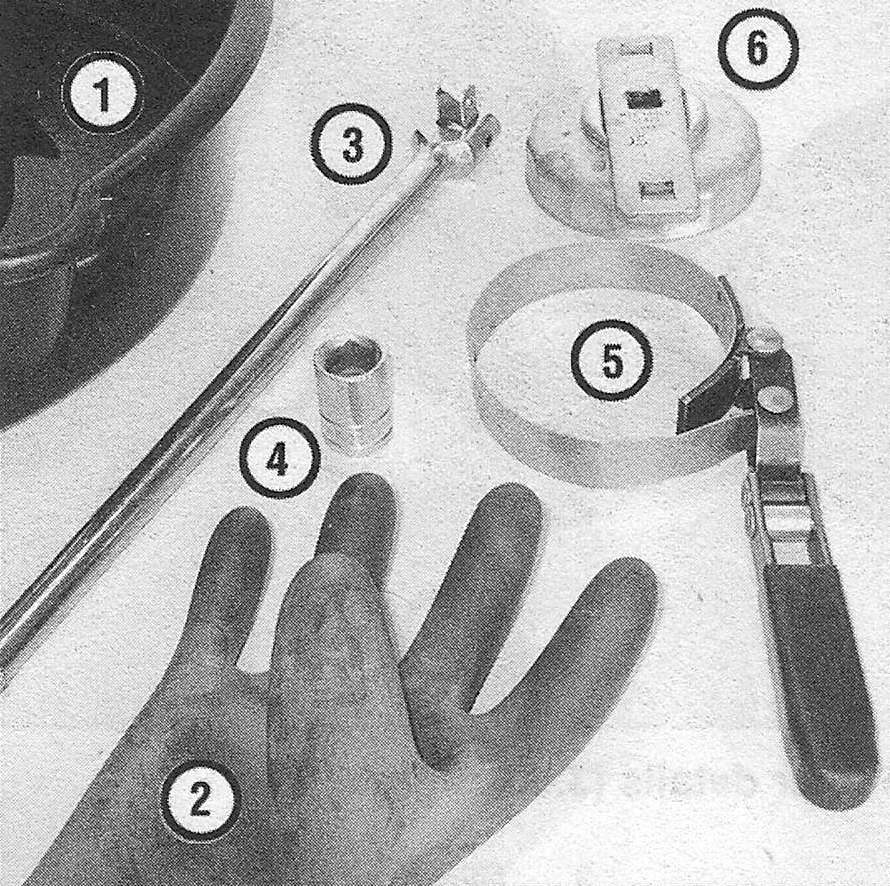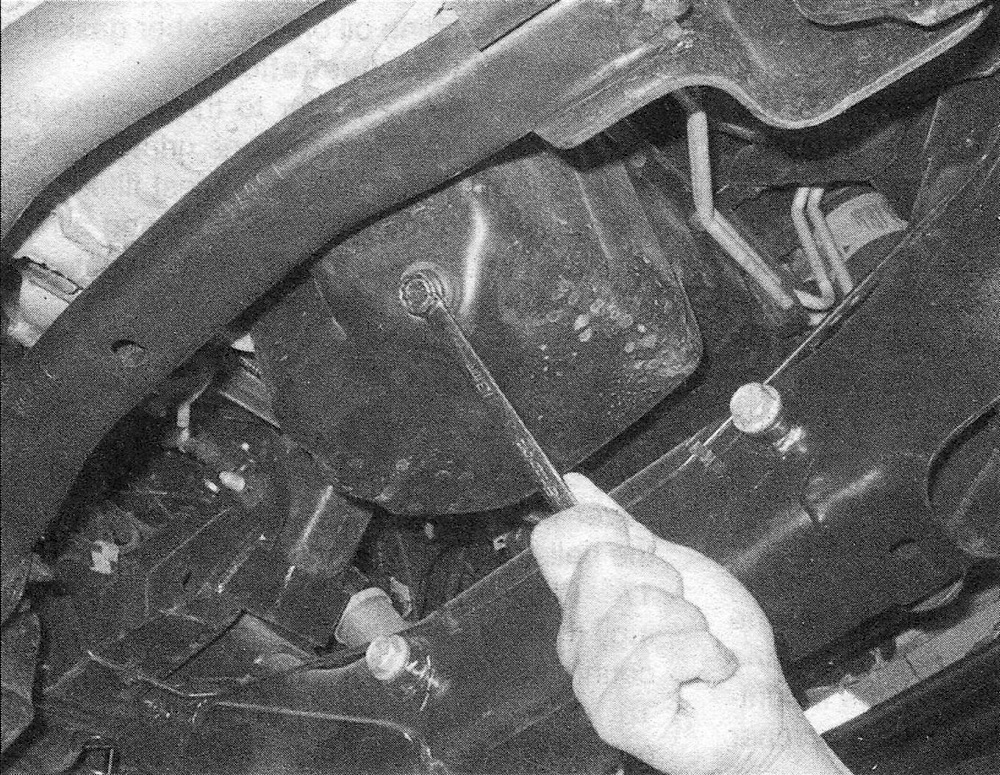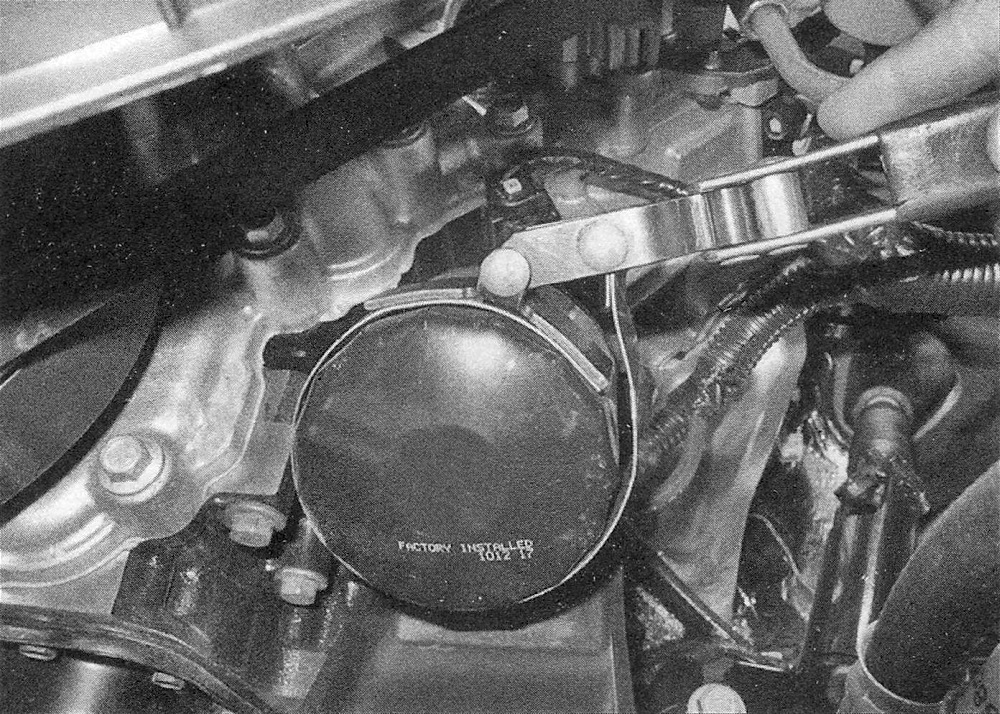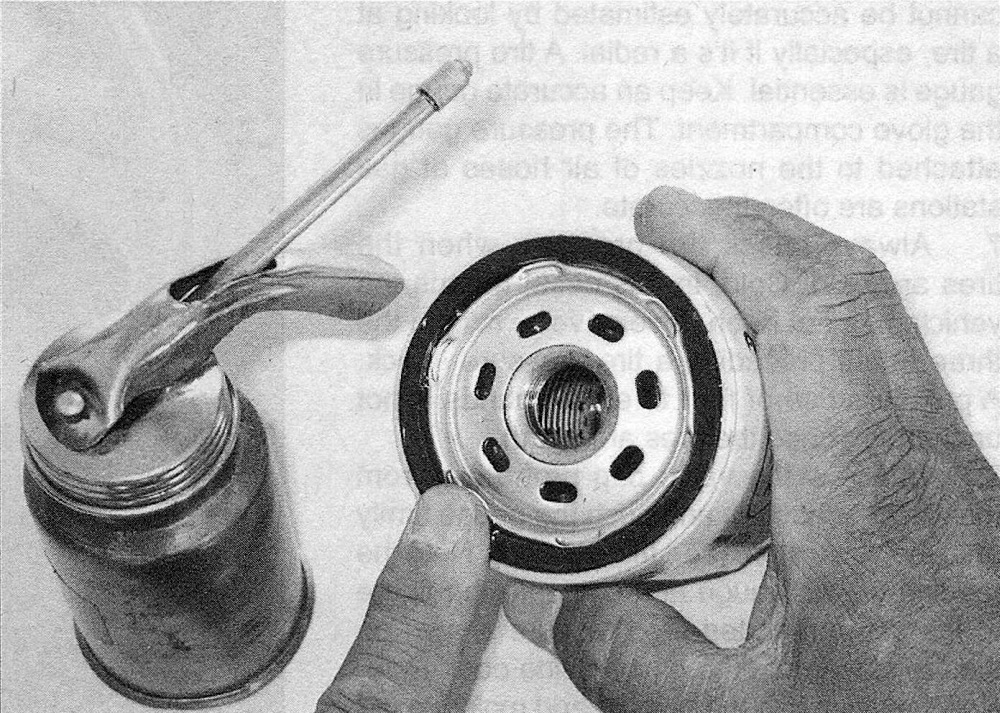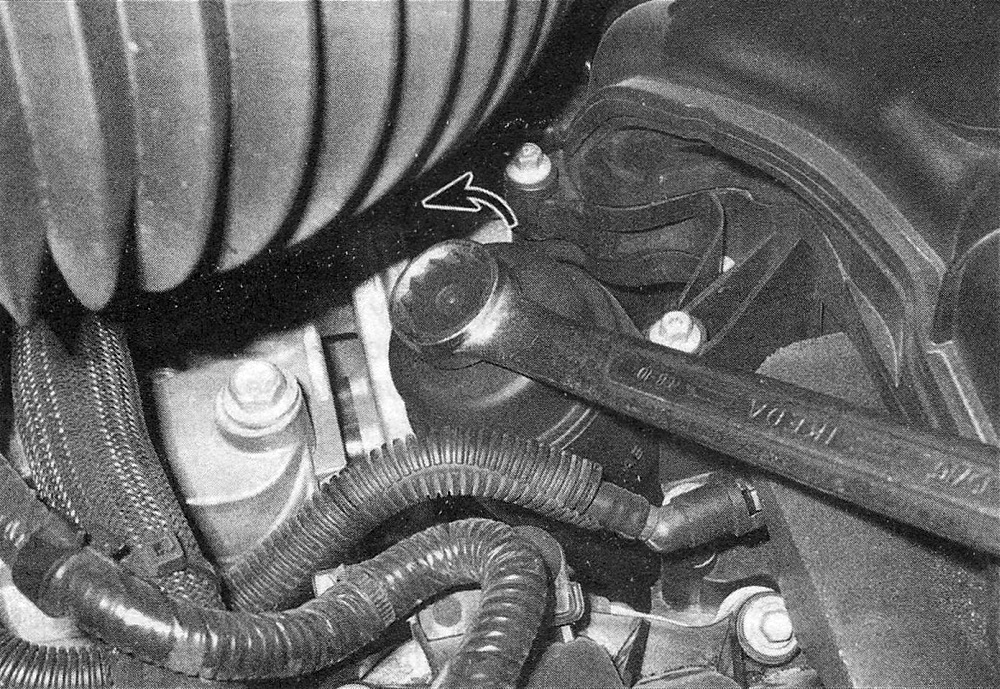Engine oil and filter change
(every 3,000 miles or 3 months)
1. Frequent oil changes are the best pre¬ventive maintenance the home mechanic can give the engine, because aging oil becomes diluted and contaminated, which leads to pre¬mature engine wear.
2. Make sure you have all the necessary tools before you begin this procedure (see illustration). You should also have plenty of rags or newspapers handy for mopping up any spills.
6.2 These tools are required when changing the engine oil and filter
1. Drain pan – It should be fairly shallow in depth, but wide in order to prevent spills
2. Rubber gloves – When removing the drain plug and filter, it is inevitable that you will get oil on your hands (the gloves will prevent burns)
3. Breaker bar – Sometimes the oil drain plug is pretty tight and a long breaker bar is needed to loosen it
4. Socket – To be used with the breaker bar or a ratchet (must be the correct size to fit the drain plug)
5. Filter wrench – This is a metal band-type wrench, which requires clearance around the filter to be effective
6. Filter wrench – This type fits on the bottom of the filter and can be turned with a ratchet or beaker bar (different size wrenches are available for different types of filters)
3. Access to the underside of the vehicle is greatly improved if the vehicle can be lifted on a hoist, driven onto ramps or supported by jackstands. Warning: Do not work under a vehicle which is supported only by a bumper, hydraulic or scissors-type jack.
4. If this is your first oil change, get under the vehicle and familiarize yourself with the locations of the oil drain plug and the oil filter. The engine and exhaust components will be warm during the actual work, so try to antici¬pate any potential problems before the engine and accessories are hot.
5. Park the vehicle on a level spot. Start the engine and allow it to reach its normal operat¬ing temperature. Warm oil and sludge will flow out more easily. Turn off the engine when it’s warmed up. Remove the filler cap from the valve cover. Note: On 3.6L engines, the oil filler cap must be removed to allow all the oil to properly drain out.
6. Raise the vehicle and support it securely on jackstands. Warning: Never get beneath the vehicle when it is supported only by a jack. The jack provided with your vehicle is designed solely for raising the vehicle to remove and replace the wheels. Always use jackstands to support the vehicle when it becomes necessary to place your body under¬neath the vehicle.
7. Being careful not to touch the hot exhaust components, place the drain pan under the drain plug in the bottom of the pan and remove the plug (see illustration). You may want to wear gloves while unscrewing the plug the final few turns if the engine is hot.
6.7 Use a proper size box-end wrench or socket to remove the oil drain plug and avoid rounding it off
8. Allow the old oil to drain into the pan. It may be necessary to move the pan farther under the engine as the oil flow slows to a trickle. Inspect the old oil for the presence of metal shavings and chips.
9. After all the oil has drained, wipe off the drain plug with a clean rag. Even minute metal particles clinging to the plug would immediately contaminate the new oil.
10. Clean the area around the drain plug opening, reinstall the plug and tighten it securely, but do not strip the threads.
11. Move the drain pan into position under the oil filter.
All except 3.6L V6 engines
12. Loosen the oil filter (see illustration) by turning it counterclockwise with an oil filter wrench. Once the filter is loose, use your hands to unscrew it from the block. Keep the open end pointing up to prevent the oil inside the filter from spilling out. Warning: The exhaust system may still be hot, so be careful.
6.12 Use an oil filter wrench to remove the filter
13. With a clean rag, wipe off the mounting surface on the block. If a residue of old oil is allowed to remain, it will smoke when the block is heated up. Also make sure that none of the old gasket remains stuck to the mounting surface. It can be removed with a scraper if necessary.
14. Compare the old filter with the new one to make sure they are the same type. Smear some clean engine oil on the rubber gasket of the new filter (see illustration).
6.14 Lubricate the oil filter gasket with clean engine oil before installing the filter on the engine
15. Attach the new filter to the engine, following the tightening directions printed on the filter canister or packing box. Most filter manufacturers recommend against using a filter wrench due to the possibility of overtightening and damaging the seal.
3.6L V6 engines
16. Lift up on the outer edges of the engine cover to disengage the rubber mounts from the ballstuds, then remove the engine cover.
17. Place a rag at the base of the filter housing, then loosen the filter cap by turning it counterclockwise (see illustration).
6.17 Using a box-end wrench or socket, turn the filter cap counterclockwise to remove it (3.6L engine
18. Remove the cap and filter from the engine, then pull the filter out of the cap.
19. Remove and discard the 0-ring from the filter cap.
20. Insert a new filter into the cap, making sure the filter clips lock into the cap (see illus tration).
6.20 Oil filter details (3.6L engine)
1 Filter element
2. Filter clips
3. Filter cap
4. 0-ring
21. Install a new 0-ring onto the cap and apply a film of clean engine oil to the 0-ring.
22. Place the filter assembly into the filter housing and carefully thread the cap into the housing. Tighten the cap to the torque listed in this Chapter’s Specifications.
All models
23. Remove all tools, rags, etc. from under the vehicle, being careful not to spill the oil in the drain pan, then lower the vehicle.
24. Add new oil to the engine through the oil filler cap in the valve cover. Use a funnel, if necessary, to prevent oil from spilling onto the top of the engine. Pour one quart less than the indicated capacity (see this Chapter’s Specifications) of fresh oil into the engine. Wait a few minutes to allow the oil to drain into the pan, then check the level on the oil dipstick (Fluid level checks). If the oil level is at or near the FULL mark on the dipstick, install the filler cap hand tight, start the engine and allow the new oil to circulate.
25. Allow the engine to run for about a minute. While the engine is running, look under the vehicle and check for leaks at the oil pan drain plug and around the oil filter. If either is leaking, stop the engine and tighten the plug or filter.
26. Wait a few minutes to allow the oil to trickle down into the pan, then recheck the level on the dipstick and, if necessary, add enough oil to bring the level to the FULL mark.
27. During the first few trips after an oil change, make it a point to check frequently for leaks and proper oil level.
28. The old oil drained from the engine cannot be reused in its present state and should be disposed of. Check with your local auto parts store, disposal facility or environmental agency to see if they will accept the oil for recycling. After the oil has cooled it can be drained into a container (capped plastic jugs, topped bottles, milk cartons, etc.) for transport to one of these disposal sites. Don’t dispose of the oil by pouring it on the ground or down a drain!
Resetting the Oil Change Required light
Note: It is possible that, driving under the best possible conditions, the oil life monitoring system may not indicate the oil needs to be changed. The manufacturer states that the oil and filter must be changed at least once every year and the oil life monitor reset.
Note: If the «Oil Change Required» message comes on when the vehicle is immediately restarted, the oil life monitor was not reset and the reset procedure must be done again. Note: If the message is not reset, it will continue to show up each time you turn the ignition switch On or start the vehicle. It is possible to temporarily turn off the message by pressing and releasing the «Menu» button.
29. Some later models have an «Oil Change Required» light. After completing your scheduled oil change, it will be necessary to reset the light.
30. Without starting the engine, turn the key to the On position.
31. Slowly depress the accelerator pedal to the floor three times within 10 seconds.
32. Turn the key to the Off/Lock position.
33. Start the engine and verify on the Electronic Vehicle Information Center (EVIC) that the «Oil Change Required» indicator message is on longer illuminated. Repeat the steps above if the «Oil Change Required» indicator message still appears.
